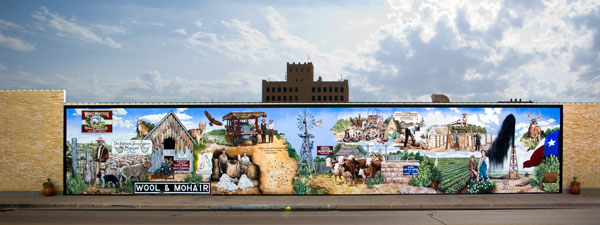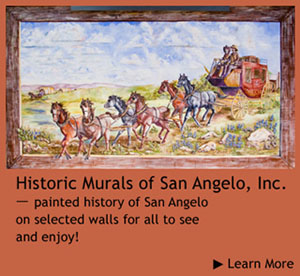West Texas Ranching Mural

107' wide x 20' high
Texas muralist Stylle Read was commissioned to paint the Ranching Mural to commemorate and pay tribute to the pioneer ranchers and their ranching descendants in this area of West Texas. Located on the west wall of Bill's Man Shop and measuring 107-by-20 feet, this is the largest of the downtown murals to date.
The wool and mohair industry in Texas dates from the early 18th century, when Spanish soldiers and missionaries brought the first sheep and goats to Texas. Starting on the left side as you face the mural, there is a mixed flock of both Chaurro sheep and Angora goats being tended by a herder, or pastore. Wool production didn�t get much attention until around 1821, when ranchers began to introduce breeds known more for their wool clips than for their mutton qualities. The Chaurro ewes were bred to Merinos and Rambouillets, the biggest and heartiest of the fine-wool sheep. Two of the sheep's usual predators, the mountain lion and the fox, are on watch in the background of the old barn, while another predator, the hawk, circles overhead. Note the member sign for the Texas Sheep and Goat Raisers Association (TSGRA), which was established in 1915 to help stop the theft of livestock on the range. In 1922, the association started the Sheep and Goat Raisers Magazine featured in the center left of the mural. The TSGRA offices are on Twohig Street in downtown San Angelo.
In the 1880s and 1890s, William L. Black played perhaps the leading role in promoting Angora meat goats and mohair production in Texas. First, with the Armour Meatpacking Company in Chicago, he began slaughtering the overpopulation of goats for their hides and tallow and packing the meat in cans under the Roast Mutton Canning Company and the product label featured in the mural's upper-left area. Black also studied the goat and its habits and forage, and wrote a pamphlet for other ranchers. The response was so good that he wrote another publication in 1900, "A New Industry, or Raising the Angora Goat, and Mohair, for Profit," which proved to be a favorite textbook for more than 40 years.
To the left of the Aerator windmill, a brand still manufactured in San Angelo, is a truck with mounted shearing machinery. The truck in this mural is an authentic 1949 model mounted with a separate International engine and all the belts and pulleys needed to drive 16 shearing drops, eight on each side of the truck bed. It is currently on display in the Barrow Museum in Eola, Texas. Using equipment like this, an experienced shearer (tasinque) could shear 100 sheep per day. This equipment revolutionized the wool industry.
To the right of the windmill, rather than the Longhorn cattle one might have expected to see on a Texas cattle ranch, there is a herd of Herefords and the sign reference to the Texas Hereford Association. There is also signage for the Texas and Southwestern Cattle Raisers Association, which has its own magazine, The Cattleman. In 1884, Charles Goodnight imported 40 bulls from Herefordshire, England, and introduced this bloodline into his Longhorn herd in Texas. The King Ranch in South Texas also experimented with the Hereford breed and successfully eradicated the menace of Texas fever. This mural features the Powell Herefords raised on the Six Mile Ranch in Ft. McKavett, Texas. We encourage you to check all of the links provided in this paragraph for a more detailed description of the Hereford cattle breed and its influence on the Texas beef cattle business.
This mural has examples of the branding methods used in the 1920s and 1930s, as well as tools, equipment, tanks and the always needed chuck wagon�well-stocked with grub for the ranch hands. There are also cotton fields, cotton pickers, and cotton-baling operations. Carl G. Cromwell (the Big Swede) was the driller who brought in the Santa Rita Oil Well #1 that roared to life on May 28, 1923. (Cromwell is featured in another historic mural titled The Cromwell Airline.)
Finally, on the right side of the mural, the Texas Whitetail deer and the Texas flag provide the finishing touch to this testimonial to the West Texas Ranchers�smart, hardworking, and patriotic stewards of the land and giants in Texas history.
|



